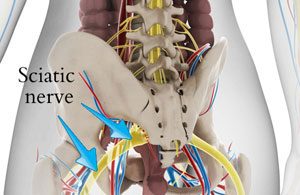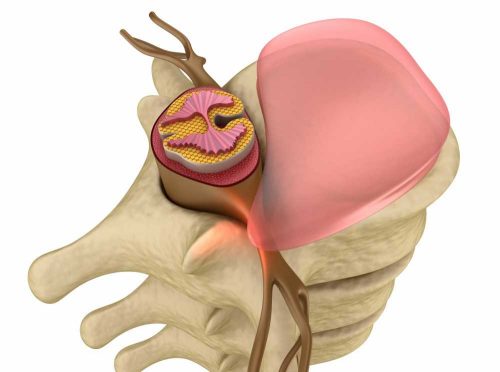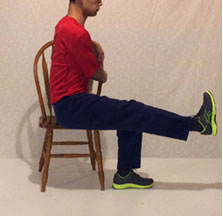
Sciatica is a very common type of radicular pain
Is Your Back Pain ‘Radicular’?
Why knowing the difference can help you find relief.
By Sherwin Nicholson | Updated May 9, 2020
Learning the symptoms of radicular pain will help you to find solutions for your discomfort faster. You don’t want to focus on the wrong solution because your condition may become worse.
What it is
It is a specific sensation that you’ll feel when pressure or damage is put on your nerve. If you have an injury, it will originate from there and then radiate down the length of your nerve.
When you have radicular back pain, it starts at the spine, travels down your spine, along your leg, and then down to your foot.
It can be as gentle as a quick, subtle sensation from just one specific point on your side or as much as a sharp, piercing one down the entire side for a long period of time.
A very common example is sciatica, where the nerve root is compressed as it exits the spine. This is NOT to be confused with piriformis syndrome which has very similar symptoms but the nerve is compressed by a tight piriformis muscle instead.
Sharp and sudden
The most obvious sign that you have it is it often feels like a sharp, stabbing sensation that’s coming from your lumbar region or hips. Much of the time, it starts entering into your foot.
When you think that it is your leg or foot that is hurting, the problem is actually beginning further upstream.
This is very common if you sit at work all day without taking any time to move around.
Be careful with what you do so to not aggravate your radicular symptoms
There is a lot you can do to worsen this condition and much of the time, it’s just from simple things such as poor work or home habits.
Radicular pain can be intensified by poor posture, bending, leaning or twisting incorrectly (much of which can be easily prevented when done safely). It can become so severe that people often describe it as one of the worst feelings that they have ever felt.

Radicular pain caused by a herniated and bulging disc.
Too much damage can compromise your quality of life
With more damage or pressure, the nerve root (where the physical impingement begins) can become so compressed that the signal that the nerve is generating gets compromised.
If the nerve gets compressed too much, it affects your ability to walk properly, sit comfortably and can reduce the sensitivity in your leg.
9 Areas to identify whether your condition is radicular or not
- It often begins suddenly and with a sharp, intense sensation down the leg. It happens frequently.
- The discomfort can be mild to moderate but in most cases feels very intense. Similar to an electric shock that immobilizes your ability to move at all.
- It begins at the buttocks, near the base of the lumbar spine, and goes down to the feet. It can be on either side or both.
- It feels as if the sensation is always traveling down a particular route in your leg. You become very sensitive to putting any pressure on parts of your leg and buttocks.
- You avoid any sudden motions that involve bending, lifting and twisting. Even merely sitting can hurt.
- Any activity can cause a sudden flare-up such as exercise or sitting.
- It can affect your bowel and bladder control in severe cases.
- It causes severe back discomfort.
- It is the most common form of sciatica, affecting 90% of cases by a herniated disc with nerve root compression.
Here are at least 10 ways that you can treat it
Now that you know 9 ways to identify the pain, here what you can do:
- Rest when possible by lying down sideways, with the injured side on top. If your discomfort is severe, resting is the most practical means at this time. Resting will allow the swelling to come down and reduce the amount of time that you put pressure on the nerve.
- You may need to temporarily take time off work or abstain from activities that may trigger it.
- Avoid putting pressure on the nerve from your activities. Since there is already pressure that is coming from your disc or vertebrae, your goal should be to reduce the activity also. Try to minimize lifting or slouching.
- Avoid excessive bending, leaning or twisting. You must find more practical ways to support your posture while you move. Maintain a healthy posture at all times while minimizing these movements.
- Use anti-inflammatory medication to reduce swelling. Avoid overuse and don’t use medication as painkillers to force your way through your daily activities.
- Ice the area for short periods of time of 20 minutes to reduce swelling. Repeat this process for no longer than a few hours.
- Use appropriate ways to correct muscle imbalances that can cause injury. This site contains many ways in which you can help to do this naturally. Take advantage of the range of information available here.
- See your health professional for an x-ray or MRI to determine the next course of treatment. You should always get consent from your doctor whenever nerves are affected. If not, you can risk permanent injury and numbness.
- Seek advice from you doctor on whether or not physical therapy is a suitable method of treatment. They are the best people to diagnose your course of action. Remember that physical therapy is intended to relieve your discomfort physically, not chemically or surgically.
- In more than 50% of cases, the pain can be settled with over-the-counter analgesics. Be careful not to become too dependent on this method as analgesics simply mask the symptoms. There is some relief from reduced swelling but it’s only temporary.
If you liked this article and need help, you’ll love:
If you sit at a desk and have pain, follow these 5 tips & exercises
Ten Exercises for Relieving Lower Back Pain
A Very Useful Stretch for Relieving Radicular Pain (Helps Piriformis Syndrome Also)
Is Degenerative Disc Disease Causing Your Radicular Pain?

The Lowbackpainprogram.com eBook teaches dozens of stretches, mobility and stability exercises intended to relieve pain and all associated muscular and joint discomfort. It is a comprehensive and thorough blend of unique and standard exercises that when done together, provide much needed relief and mobility.
One of the best ways to reduce or treat these conditions, is to reduce or remove the tension and pressure (muscular and mechanical) which builds over the surrounding the area.
If you have back problems with chronic discomfort, chances are: your hips are tight, your back is stiff and your leg strength is quite weak. You then develop of cycle to avoid moving properly just to avoid hurting more. The cycle only gets you weaker and more prone to the injury.
Please cruise my site to learn many methods for relieving back issues. I firmly believe and teach the importance of muscle reconditioning and stretching. There is a very good chance your muscles are affecting you now and there is always room for improvement. By working on your hip muscles, you will be able to get on your path to recovery.
References:
-
Lumbar radic. pain – https://www.ncbi.nlm.nih.gov/pubmed/15253601 Aust Fam Physician. 2004 Jun;33(6):409-12. Govind J1.
-
Pathophysiology of radic. pain – https://www.ncbi.nlm.nih.gov/pubmed/15741680Clin Calcium. 2005 Mar;15(3):57-62.Kawakami M1.
-
Diagnosis and treatment of sciatica – https://www.ncbi.nlm.nih.gov/pmc/articles/PMC1895638/BMJ. 2007 Jun 23; 334(7607): 1313–1317. B W Koes,
